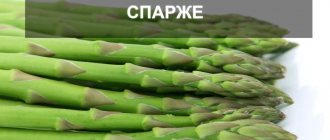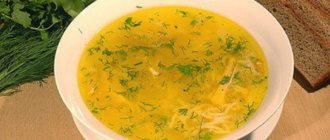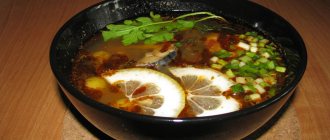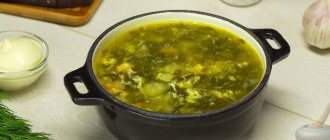What is lecho, how is it made in industrial conditions and prepared at home. Nutritional value, composition, benefits and harm to the body. Use in cooking, recipes.
Lecho is a concentrated vegetable mixture, a classic dish of the national cuisine of Hungary, the main ingredients of which are tomatoes, sweet peppers and onions. There are many recipes: the ingredients can be raw, boiled, stewed. The structure is heterogeneous, pieces of vegetables are felt; texture - thick, pasty; color - red or orange; taste - sweetish-sour, spicy; smell - can be either weak or intense, depending on the amount of spices. Serve as a condiment, side dish or main dish.
How is lecho made?
The production process is 90% automated. The ingredients arrive after primary processing, that is, the vegetables have already been washed and household contaminants and foreign matter have been removed.
The production line is equipped with the following units
:
- A machine for cutting peppers, washing and removing the remaining seeds is carried out in a centrifuge with a constant supply of water and a horizontal drum. Interestingly, the fruits are placed into special nests by hand.
- Device for peeling and slicing onions.
- Stirrer for mixing prepared vegetables.
- For heat treatment, a blancher or autoclave with a high-pressure chamber is used. This way it is possible to preserve the maximum amount of useful substances.
- To prepare lecho in industrial conditions, the tomato filling is made separately. Tomato paste arrives ready-made, and heating containers and stirrers are used to achieve the desired consistency and taste.
- The jars are loaded into an automatic dishwasher and additionally sterilized with a stream of steam. Then the containers are placed on a carousel and filled with chopped vegetables. A pressing device is installed in the line or this process is carried out manually.
- The filling is pumped through a pipeline into a vacuum filler to prevent the formation of air bubbles during packaging.
- Jars of vegetables are sent along a conveyor to a filler, and then to a machine that tightens the lids - a “twist-off”.
- Next, they make lecho like all canned vegetables, that is, they send it to an autoclave for sterilization, then the jars are washed, dried and labeled.
After production, the products are shipped to a warehouse, where they are placed in boxes with several divisions. The shelf life of lecho is calculated not from the moment of shipment, but from the date of manufacture and storage. Despite the fact that the microclimate of the room is 8-10°C, the store stores canned food at 18-24°C.
Before you buy lecho, it is advisable to pay attention to the following signs
:
- cuttings - the larger they are, the tastier the seasoning;
- type of pieces - they must be crushed to the same size;
- uniformity of the marinade;
- packaging tightness.
The bright red color of the sauce indicates that it contains artificial colors. High-quality fill is moderate red, with an orange tint. After opening the jar, it should be stored for no more than 2 days in the refrigerator.
How to prepare lecho yourself:
- A classic recipe for the winter
. First they do the refueling. Chop the tomatoes (2 kg), add salt (1 heaped tablespoon) and sugar (half a glass), set to simmer over very low heat, stirring constantly. Bell peppers (the color does not matter, but it is better to choose red or green, fleshy, more spicy ones) are cut into petals, removing the partitions and seeds. Onions are taken to taste (250-500 g), but you can do without it. If you overdo it with this ingredient, it will taste bitter. Pieces of pepper (2.5 kg) and chopped onions are dipped in boiling tomato juice and sunflower oil (0.5 cup) is added and cooked for 30 minutes. It’s better to add fire first and then turn it down. Just before turning off, pour in 1 tbsp. l. vinegar and stir. Pour into sterilized jars and roll up the lids. For better storage, you can sterilize for an additional 15 minutes. Cool the preserved food under a blanket, turning the jars over. - Fresh lecho
. All vegetables are washed - however, a good housewife does not need such an instruction. Bell peppers (3 pcs.) are cut into petals or rings, seeds and partitions are removed, onion is chopped (1 head) and sautéed in sunflower oil. Grated carrots are sent to it, and then pepper. While everything is stewing under the lid, they deal with tomatoes (1 kg). You need to get rid of the skin. To do this, the fruits are dipped in boiling water for 1-2 minutes or cranked in a meat grinder or crushed in a blender and rubbed through a sieve. Pour in tomato sauce when the peppers and carrots become soft, add crushed garlic, add salt, pepper, and stir for 10-15 minutes. The homemade sauce is almost homogeneous, the vegetables are boiled. Fresh lecho cannot be stored for long periods of time.
Additional seasoning ingredients can include fresh cucumbers, zucchini, and eggplant. With a quick, fresh recipe you can experiment endlessly. But in order to make high-quality homemade lecho for the winter, you must follow certain preparation rules. Choose meaty vegetables, peel tomatoes, remove pepper seeds. By the way, tomato paste is often used as a filling - 1.5 kg of tomatoes are replaced by 300 g of paste diluted in 1 liter of water.
If the dish is eaten fresh, then you can use different types of seasonings - fresh herbs, savory herbs, Provençal mixture, etc. Vinegar is not necessary, unlike winter preparations. But in them it is better to limit yourself to traditional salt, pepper and garlic. It is stored better this way, and additional flavoring additives are added before serving.
Lecho
Lecho is a classic Hungarian dish that does not have an exact recipe. The composition necessarily includes bell peppers, ripe tomatoes and onions. Any available vegetables and spices are used as additional ingredients: carrots, ground pepper, bay leaf, cloves, chili peppers, fried onions.
Did you know? Classic Hungarian lecho is eaten as a separate dish with plenty of white bread. Before serving, combine it with stirred eggs.
Hungarians also love to cook lecho with homemade sausages and smoked meat.
Manufacturing
You can prepare lecho yourself or purchase a ready-made product.
The cooking process is not complicated. First, prepare the marinade with the addition of spices, herbs, tomatoes and other ingredients according to the recipe. Then add sweet peppers, cook for no more than half an hour, season with vinegar and place in sterilized jars.
Curious! Lecho can also be consumed freshly prepared.
Compound
Lecho is an excellent source of vitamins and other useful substances. That is why the product is so popular in European countries and in Russia.
Lecho retains most of the vitamin C, A, PP, B1, B5, B6. The mineral composition of the product is no less diverse, represented by selenium, phosphorus, magnesium, calcium, zinc, manganese and iron.
Interesting fact! The chemical composition of lecho can vary, it all depends on the ingredients used for its preparation.
Benefit
With regular consumption of the valuable bell pepper product, the body is enriched with vitamins and minerals. The product is especially beneficial in winter, when there is a shortage of fresh vegetables everywhere.
Using lecho, you can:
- strengthen blood vessels;
- avoid depression;
- improve skin condition;
- improve memory and vision.
- normalize blood pressure;
- strengthen the immune system.
Interesting fact! Basically, lecho has a low calorie content, which gives grounds to classify it as a dietary product.
Harm
Consuming homemade remedies cannot have a detrimental effect on your health. But a store-bought product may contain not very useful preservatives and food additives, so you need to carefully study the composition of the lecho before purchasing.
Use in cooking
You can prepare many delicious dishes based on lecho: stewed beef or pork with lecho, stew, chops with lecho. The finished product can be added to soups, borscht, cabbage soup, pickles, pies, and pizza.
Lecho is often served as a side dish for the main dish, complemented by vegetable side dishes, meat and fish dishes.
The product also goes well with smoked products, especially sausages and meat.
Interesting fact! Lecho is a variation of the famous dish ratatouille, adjusted to the products available in Hungary.
How to choose
To purchase a quality product, you need to pay attention to the following signs:
- the larger the ingredients, the tastier the lecho will be;
- uniform cutting;
- the marinade is homogeneous, without lumps;
- a pronounced color indicates the presence of dyes;
- can tightness;
- composition, which should contain only vegetables, vinegar and salt.
Valuable advice! The tightness of the lid is checked when opening the jar; a pop should be heard.
If the jar is not sealed, you should not take the risk and consume the product.
How to store
Store lecho in a dark, cool place at room temperature. Started jars can be stored for no more than 2 weeks.
dom-eda.com
Composition and calorie content of lecho
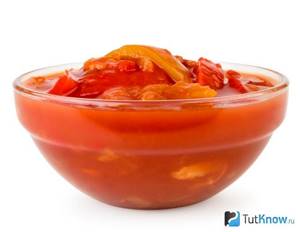
The nutritional value of the seasoning depends slightly on the recipe.
Calorie content of lecho is 68-89 kcal per 100 g, of which
:
- Proteins - 1.2 g;
- Fats - 2.6 g;
- Carbohydrates - 7.2 g;
- Dietary fiber - 1.7 g;
- Ash - 0.9 g;
Since lecho is most often served at the table in the form of homemade preparations, let’s consider the vitamin and mineral composition of just such a product.
Vitamins per 100 g
:
- Vitamin A - 531.9 mcg;
- Beta Carotene - 3.192 mg;
- Vitamin B1, thiamine - 0.066 mg;
- Vitamin B2, riboflavin - 0.068 mg;
- Vitamin B4, choline - 1.67 mg;
- Vitamin B5, pantothenic acid - 0.111 mg;
- Vitamin B6, pyridoxine - 0.224 mg;
- Vitamin B9, folate - 9.414 mcg;
- Vitamin C, ascorbic acid - 106.92 mg;
- Vitamin E, alpha tocopherol - 1.696 mg;
- Vitamin H, biotin - 0.411 mcg;
- Vitamin K, phylloquinone - 4.4 mcg;
- Vitamin PP - 0.8791 mg;
- Niacin - 0.711 mg.
Macroelements per 100 g
:
- Potassium, K - 191.12 mg;
- Calcium, Ca - 13.52 mg;
- Magnesium, Mg - 15.64 mg;
- Sodium, Na - 102.23 mg;
- Sulfur, S - 3.44 mg;
- Phosphorus, P - 25 mg;
- Chlorine, Cl - 163.07 mg.
Microelements per 100 g
:
- Aluminum, Al - 60.4 μg;
- Boron, B - 28.7 µg;
- Iron, Fe - 0.619 mg;
- Iodine, I - 0.5 μg;
- Cobalt, Co - 1.534 μg;
- Lithium, Li - 1.122 μg;
- Manganese, Mn - 0.0355 mg;
- Copper, Cu - 28.11 μg;
- Molybdenum, Mo - 2.02 μg;
- Nickel, Ni - 3.242 μg;
- Rubidium, Rb - 38.2 μg;
- Selenium, Se - 0.118 μg;
- Fluorine, F - 4.99 μg;
- Chromium, Cr - 1.25 μg;
- Zinc, Zn - 0.0514 mg.
But the benefits and harms of lecho are due not only to the rich vitamin and mineral complex. The composition contains nonessential and essential amino acids - 12 and 8 types, respectively, phytosterols, lycopene, pectins, organic acids, essential oils.
There is no need to be afraid, even with daily use you will not gain weight. Homemade lecho contains a small amount of vegetable oil, but this does not mean that harmful cholesterol enters the body.
- Saturated - 0.3 g;
- Monounsaturated - 0.6 g;
- Polyunsaturated - 1.5 g;
- Sterols - 5 g.
Freshly prepared seasoning can be included in a diet for weight loss, used to stimulate the appetite of patients recovering from debilitating illnesses, the elderly and children from the age of 1.5 years.
Health benefits and harms of adjika
Adjika is the basis of Abkhazian cuisine. It is eaten with fish, beans, cheese, tortillas, corn porridge, and vegetables. This spicy paste is used to season meat and melons. Like all nouns of the Abkhaz language, the word “aџyka” begins with “a”.
Legend has it that adjika has been known since ancient times, when salt was very expensive and not available to everyone.
For many generations, women of Abkhaz villages have preserved unique recipes (each family has its own).
Previously, adjika was cooked on a special flat stone (Abkh. “akhakya”). Another oblong (Abkh. "apkhnyga") stone was squeezed with two hands, and all the ingredients were ground to a plastic mass or powder. Until now, in the fall, in mountain villages, they take out weighty grater stones from the basements, wash them, dry them in the sun, and begin to grind the peppers with garlic and herbs.
At first glance, it seems that adjika is just a seasoning, moreover, quite spicy, but is it beneficial for the body? As a rule, many people perceive spicy food as a priori unhealthy. However, this is not so, the beneficial properties of adjika are quite strong, and by consuming adjika in reasonable quantities you can not only diversify the taste of your usual dishes, but also improve your health. The benefits of adjika are undoubtedly the result of the combination of beneficial properties of its components. The benefits of garlic, combined with the benefits of basil, dill, thyme, and other herbs, have the most beneficial effect on health. Of course, the benefits of adjika largely depend on the portion and regularity of use of this product.
It is also worth knowing that adjika acts directly as a digestive stimulant, increases appetite, has a warming effect, improves metabolism and improves the secretion of gastric juice. But due to its strong pungency, adjika should not be used by those who have disorders of the mucous membrane of the digestive organs (ulcers, gastritis), and it is also not recommended for pregnant and lactating women and small children.
Regular consumption of adjika can significantly strengthen the immune system and strengthen the body's defenses. Plant phytoncides contained in adjika help kill viruses and bacteria. This product is also useful for the prevention of respiratory diseases, especially viral ones.
The pungency and pungency inherent in adjika undoubtedly enhance a person’s energy potential, increase activity, give strength, and also that adjika increases sexual power, increases potency, and improves blood circulation in the genitals.
Do not forget about a very important fact, such as the consumption of adjika affects the functioning of the circulatory system, tones the blood vessels, the product helps cleanse the blood vessels of cholesterol plaques.
Adjika, containing tomato juice or paste, in addition to spices, is also beneficial for the body. The beneficial properties of tomato juice enhance the benefits of this product.
Useful properties of lecho

Sauce with pieces of vegetables is a dietary dish and helps to cope with many organic problems due to its rich composition.
- Enhances the production of pancreatic and stomach enzymes, accelerates the digestion of food, stops putrefactive and fermentative processes in the intestines, and improves the speed of peristalsis.
- Activates metabolism.
- Accelerates the removal of waste and toxins.
- Normalizes the functioning of the cardiovascular system, increases capillary tone, thereby improving the quality of the surface epithelium.
- Stimulates the work of hair follicles and prevents splitting of nail plates.
- Suppresses the production of atypical cells, reduces the likelihood of the development and degeneration of cancerous tumors.
- Due to the fact that lecho contains a rich complex of vitamins B, regular use normalizes the functioning of the nervous system, helps to cope with depression and recover from emotional overload, improve sleep and avoid nervous breakdowns.
- Normalizes blood pressure, increases vascular tone.
A high amount of ascorbic acid in the lecho will help activate the immune system during the epidemic season, reduce the likelihood of getting sick and avoid complications if it was not possible to prevent the introduction of the virus. Phytosterols, which resemble human hormones in structure, improve the functioning of the endocrine system, prolong youth and preserve female beauty.
Contraindications and harm of treatment

If you regularly include a vegetable dish in your daily menu, you should analyze your own feelings and monitor the condition of young children. After all, the color red is a high allergic hazard, and it also contains a lot of hot spices that can provoke the development of dysbacteriosis.
Do not add ingredients to homemade preparations that cause an allergic reaction. If your diet includes self-prepared treatment, you don’t have to worry about the symptoms of individual intolerance - eating disorders and intoxication. However, it is worth taking into account the possible microbiological danger - botulism develops not only from the consumption of low-quality canned meat and fish, but also when sanitary and hygienic rules are violated when cutting, rolling and storing home canned food.
If souring can be determined by appearance and taste, then the bacteria that cause botulism do not in any way affect the appearance and nutritional quality of the product. Therefore, when treating children, pregnant women, lactating women and people with weak immune systems, it is advisable to first sterilize the product at 80°C for 30 minutes. The vitamin-mineral complex will suffer slightly, and the amount of lycopene, a substance with antioxidant properties, will only increase. The pop that appears when opening the can is not a guarantee of quality.
The microbiological hazard of store-bought products is low, but stabilizers, preservatives, and flavoring additives must be added during production. It is these components that can have a negative effect on the body of people who are in a “special status” - young children and people with a tendency to frequent allergic reactions. In addition, it must be taken into account that, despite the GOST lecho 34126-2017 approved in 2021, the recipe may change, albeit slightly.
Unscrupulous manufacturers sometimes introduce additional ingredients, use dried vegetables instead of fresh or frozen ones, or introduce dyes. You should be careful and avoid unfamiliar brands, carefully read what is written on the packaging before purchasing.
Abuse of lecho causes harm due to increased sensitivity of the mucous membrane lining the gastrointestinal tract, during exacerbation of peptic ulcer disease or inflammatory processes of the urinary system - with pyelonephritis, cystitis. Do not get carried away with seasoning for chronic pancreatitis and cholelithiasis. The property of accelerating bile secretion can provoke the advancement of stones and cause painful colic.
Lecho. Calorie content, benefits and harm. — YourTaste
- /system/ingredients/images/images/5483/7dc4/7661/7322/5b95/0100/gal/liecho9.jpg?1417903553
- /system/ingredients/images/images/5483/7dc4/7661/7322/5b96/0100/gal/liechopieriets.jpg?1417903555
- /noimage/ingredient/thumb.png
Lecho is a vegetable dish that came to us from Hungarian cuisine. There are a huge number of recipes for preparing lecho, but the general principle and main components are not very different. Vegetables serve as the basis for preparing lecho. Usually these are sweet bell peppers, tomatoes and onions. Prepared and chopped vegetables are stewed with the addition of chopped tomatoes and various spices and seasonings are added during the cooking process to improve the taste. Bay leaf, allspice, and garlic give the vegetable dish a special aroma. Lecho is prepared in several ways and can be consumed either freshly prepared or canned. In our country, lecho is a popular preparation for the winter. Peculiarities of preparation and long-term heat treatment can significantly increase shelf life. The recipe for lecho may include boiled rice, carrots, apples, beans and other ingredients.
The ingredient lecho is widely used in cooking and is a kind of preparation that allows you to quickly prepare a huge number of delicious dishes. Vegetables in tomato sauce perfectly complement pizzas, meat pies, and soups. Beef and pork stewed with lecho, Hungarian chops, stews and many other dishes with lecho have a high nutritional value and saturate the body with useful substances at any time of the year. As an independent dish, lecho complements side dishes, meat and fish products well.
Benefits of lecho
Lecho generally has a low calorie content, which allows this ingredient to be classified as a dietary product. The benefits of lecho are determined by its main components. Vegetables that are used in cooking, after cooking, retain beneficial microelements and vitamins.
Harm and contraindications
Lecho prepared in industrial settings may contain harmful preservatives and additives that extend shelf life.
vashvkus.ru
Recipes for dishes with lecho

As already mentioned, the seasoning is universal. It can be eaten as a separate dish or used as a side dish or sauce.
- Pork goulash
. The pulp (1.5 kg) is cut into small pieces and fried in its own fat. You can first lubricate the cauldron or cast iron with vegetable oil, just use just a little, then the fat will melt and drown out the foreign taste. When a golden brown crust appears, pour in water (0.5 l), simmer for 25 minutes, add pre-fried flour (60 g), salt, pepper. Stir, turn down the heat to low. After 5 minutes, pour in 400 ml of lecho, bring to a boil and simmer until the meat is completely cooked. Before serving, sprinkle with fresh herbs. - Pizza with lecho
. At home, if you have pizza base on hand, the dish can be prepared within 15 minutes. Preheat the oven to 190°C, place the workpiece on a baking sheet, lightly greased with oil, pour lecho, place fried onions and pieces of sausage on top and sprinkle everything with grated cheese. Once it melts, you can eat it. You can make the base yourself: knead the dough using flour (2 tbsp), mayonnaise (2 tbsp) and one egg, add a little salt. It is better to make pizza from liquid dough in a slow cooker or use a silicone mold rather than a baking sheet.
Interesting facts about lecho

Lecho is one of the dishes that does not have a constant classical recipe. It is often compared to ratatouille, but rather it is an adapted version of the Italian pisto and the Moroccan (Israeli) matbuha sauce. The first mentions of lecho can be found in cookbooks dating back to the 17th century, but the name itself appeared only in 1930, and the modern version only in cookbooks of 1940. The product began to be produced under its modern name.
It is interesting that bell pepper, which is considered the main ingredient of the seasoning, is not included in the composition by Hungarian housewives. We use bright and juicy Californian pepper, which itself has no aroma or strong taste. But it retains its crunchiness after heat treatment and has no “competitors” for this quality in its fresh form.
The flavor is added by paprika of the Szeged variety, which is collected before ripening. Due to its special quality - the unique composition of essential oils - no seasonings are added to the classic sauce, limiting it to salt.
The ingredients of later versions of lecho are Moroccan and regular onions, bell peppers, red, ripe paprika, garlic, and spices. Eventually, the name “lecho” was given to all sauces with pieces of vegetables drenched in tomato sauce. There are even fans who pour hot pepper pods on tomatoes.
How to prepare lecho - watch the video:
Don't miss out on this tasty and healthy addition to your diet. Fresh seasoning will delight you in the summer, and canned seasoning will replenish your vitamin and mineral reserves in winter. But if you have a choice, preference should be given to homemade products or pay attention to the recommendations described above for choosing a store-bought product.
- Related article: Spaghetti sauce - lecho with wine and basil
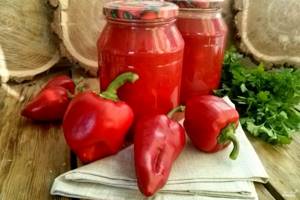
| Save | I cooked) | Estimate |
Lecso (Hungarian lecsó) is a popular tasty dish of Hungarian cuisine. Can be served as a side dish or as a separate dish. Each housewife has her own version, but I want to present you with a classic recipe for lecho.
Composition of lecho
It should be noted that, as such, there is simply no single recipe or composition of lecho. The thing is that each housewife prepares a dish according to her own recipe. Fortunately, various types of vegetables are suitable for lecho. However, lecho will necessarily contain three main ingredients - tomatoes, preferably highly ripened ones, bell peppers and onions.
The calorie content of lecho is at a very low level and amounts to only 89 Kcal per 100 grams of vegetable product. Such a low calorie level of lecho has never happened before due to the recipe of the dish. To make lecho, only vegetable ingredients are used. Most vegetables are considered low-calorie and dietary foods. Therefore, lecho can also be safely classified as a dietary, and most importantly, healthy food product.
How to cook “Lecho (classic recipe)”
Rate the Lecho recipe (classic recipe):
Please enter the characters from the picture
Cooked, added fried onions and carrots
I love lecho, I make it every year, even in winter, when the summer canning ends
Of course it turns out delicious, but I fell more in love with the “tomato” lecho, it’s no worse than homemade, and you don’t need to stand and cook) I opened the jar and that’s it) you can buy it in any store, and the composition is natural.. beauty in general
I also add onions to the lecho, cut them very coarsely, like the peppers, into large cubes. This is the most delicious preparation!
Lecho is my weakness, it’s such a delicious salad.
Traditional tandem of bell peppers and tomatoes and unusual combinations with eggplants, zucchini and other vegetables.
